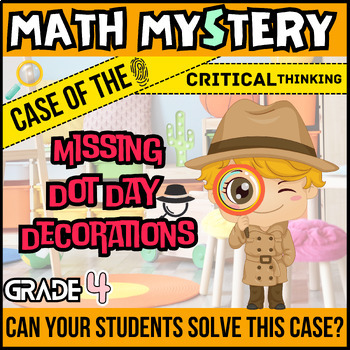Math Mystery - Missing Dot Day Decorations - Multiplication Mystery Picture
- PDF
What educators are saying
Description
Math Mystery - Missing Dot Day Decorations - Multiplication Mystery Picture
This exciting Math Mystery activity book is filled with math puzzles , Multiplication Mystery Picture and clues that will keep you students engaged and entertained.
As you help the detectives crack the case, they will learn about prime and composite numbers—what makes them special and how they're different. they will also explore rounded numbers, discovering how they're used in everyday life.
But that's not all! Get ready to dive into the world of shapes and symmetry. they will find out what makes shapes symmetrical and uncover their hidden patterns.
Students must use their fraction math skills to discover who took the Dot Day Decorations.
This book is perfect for fourth graders who love math and enjoy solving mysteries. Whether you're a teacher or a parent, you'll find this book a fantastic resource to make learning math a fun adventure!
Easy prep! Just Print & Solve!
Suggestion: To ensure that the entire class stays on the same page, it is recommended to pace the clues one by one. If you choose to use the clues in a different order, it's important to keep the suspect list away from the students until all five clues have been completed and discovered. This way, everyone can have an equal opportunity to engage in the mystery-solving process without revealing any spoilers too early.
Preparation: No Prep required! simply print the student pages and either staple them together or place them in a folder. Your students will be ready to dive into the activity, making it a convenient and time-saving resource for seamless integration into your lessons.
Multiple Uses:
- Suitable for independent, pairs, or group work.
- Use as part of your math centers, add to your sub tubs, make it part of your early finisher tasks, give for homework, or make it part of your classroom practice/review sessions.
I recommend pacing this activity by giving students one clue at a time. Once the whole class has completed a clue, then move on to the next clue, either within the same lesson or the next math session.
How long will this activity take?
Time to complete will vary, ranging from approximately 30 minutes to 2 hours or more! The duration largely depends on your students' familiarity with the math mystery format and their level of comfort with the math skills addressed in the specific mystery.
Math aficionado on the hunt for the next great read? Your adventure starts with these links:
Math Mysteries - Missing Dot Day Decorations
Mystery Of Missing Gingerbread Houses
The Mystery of the Missing Fireworks
Note:
This is a Digital Product. You can download and print as many times as you like.
Be sure to follow Me to receive updates and notices about sales and new products.





